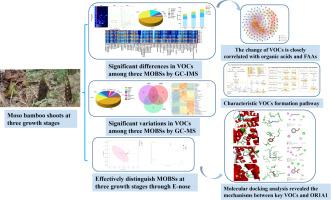毛竹不同生长期挥发性有机化合物的鉴定与解析:HS-GC-IMS、HS-SPME-GC - MS、电子鼻和分子对接联合分析
IF 8
1区 农林科学
Q1 FOOD SCIENCE & TECHNOLOGY
引用次数: 0
摘要
毛竹(Phyllostachys edulis L.)笋(mobs)以其独特的风味和营养价值而闻名于世。然而,它们的快速增长导致了不同发育阶段质量的显著差异。本研究采用顶空-气相色谱-离子迁移谱法(HS-GC-IMS)、顶空固相微萃取-气相色谱-质谱法(HS-SPME-GC-MS)、电子鼻(E-nose)和分子对接等多平台方法,综合表征了MOBS在低、中、高三个生长阶段挥发性有机物(VOCs)的动态变化。通过HS-GC-IMS和HS-SPME-GC-MS分别鉴定出64种和39种VOCs,其中13种关键化合物分别为1-己醇、1-戊醇、3-甲基-1-丁醇、(E,E)-2 -庚烯醛、1-庚醇、(E,E)-2,4-非二烯醇、异戊酸丙酯、苯甲醛、1-辛烯醇-3-醇、水杨酸甲酯、己酸甲酯、癸醛和(E)-2-辛烯醇,可作为区分生长阶段的潜在生物标志物。这些化合物有效地反映了MOBS风味谱的动态演变,主要来源于氨基酸分解代谢和脂质氧化途径。8种有机酸和17种游离氨基酸(FAAs)在生长过程中表现出显著的动态变化。相关网络分析显示,VOCs、有机酸和FAAs之间存在很强的相互关系,表明在生长过程中有协调的代谢调节。分子对接表明,四种特征VOCs - (E)-2-庚烯醛、苯甲醛、1-辛烯-3-醇和水杨酸甲酯与人类嗅觉受体之间具有很强的结合亲和力,为MOBS的特征香气提供了分子基础。这项工作建立了MOBS的第一个生长阶段分解VOC谱,并强调了综合分析技术在植物挥发物中的价值。研究结果为竹笋的精准采收和定向加工提供了科学依据,提高竹笋感官品质,促进竹笋在食品工业中的增值应用。本文章由计算机程序翻译,如有差异,请以英文原文为准。

Characterization and decoding of volatile organic compounds in Moso bamboo shoots (Phyllostachys edulis L.) at different growth stages: A combined analysis by HS-GC-IMS, HS-SPME-GC‐MS, E-nose, and molecular docking
Moso bamboo (Phyllostachys edulis L.) shoots (MOBSs) are a highly valued food resource known for their distinctive flavor and nutritional benefits. However, their rapid growth leads to significant variations in quality across developmental stages. This study presents a novel multi-platform approach combining headspace-gas chromatography–ion mobility spectrometry (HS-GC-IMS), headspace solid-phase microextraction–gas chromatography–mass spectrometry (HS-SPME-GC-MS), electronic nose (E-nose), and molecular docking to comprehensively characterize the dynamic changes in volatile organic compounds (VOCs) of MOBS at three growth stages (low, medium, and high). A total of 64 and 39 VOCs were identified by HS-GC-IMS and HS-SPME-GC-MS, respectively, among which 13 key compounds—1-hexanol, 1-pentanol, 3-methyl-1-butanol, (E)-2-heptenal, 1-heptanol, (E,E)-2,4-nonadienal, propyl isovalerate, benzaldehyde, 1-octen-3-ol, methyl salicylate, methyl hexanoate, decanal, and (E)-2-octenol—were identified as potential biomarkers for discriminating growth stages. These compounds effectively reflected the dynamic evolution of MOBS flavor profiles and were primarily derived from amino acid catabolism and lipid oxidation pathways. Additionally, eight organic acids and 17 free amino acids (FAAs) were quantified, showing significant dynamic changes during growth. Correlation network analysis revealed strong interrelationships among VOCs, organic acids, and FAAs, suggesting coordinated metabolic regulation during growth. Molecular docking demonstrated strong binding affinities between four signature VOCs—(E)-2-heptenal, benzaldehyde, 1-octen-3-ol, and methyl salicylate—and human olfactory receptors, providing a molecular basis for the characteristic aroma of MOBS. This work establishes the first growth-stage-resolved VOC profile of MOBS and highlights the value of integrated analytical techniques in plant volatilomics. The findings provide a scientific basis for precision harvesting and targeted processing of bamboo shoots to enhance sensory quality and promote value-added applications in the food industry.
求助全文
通过发布文献求助,成功后即可免费获取论文全文。
去求助
来源期刊

Food Research International
工程技术-食品科技
CiteScore
12.50
自引率
7.40%
发文量
1183
审稿时长
79 days
期刊介绍:
Food Research International serves as a rapid dissemination platform for significant and impactful research in food science, technology, engineering, and nutrition. The journal focuses on publishing novel, high-quality, and high-impact review papers, original research papers, and letters to the editors across various disciplines in the science and technology of food. Additionally, it follows a policy of publishing special issues on topical and emergent subjects in food research or related areas. Selected, peer-reviewed papers from scientific meetings, workshops, and conferences on the science, technology, and engineering of foods are also featured in special issues.
 求助内容:
求助内容: 应助结果提醒方式:
应助结果提醒方式:


